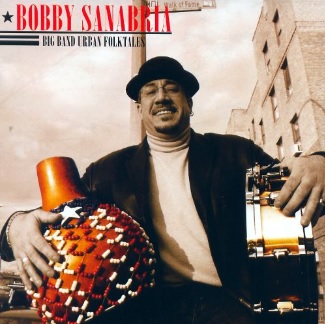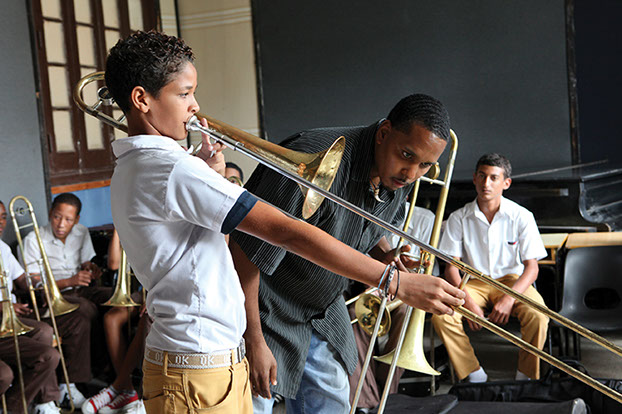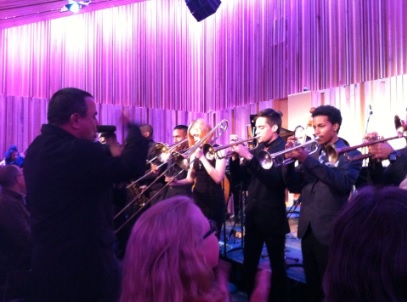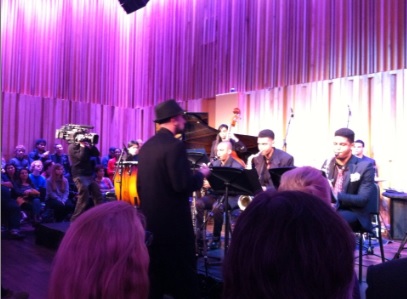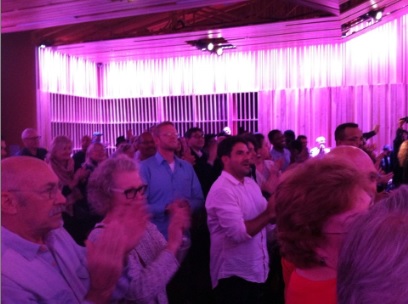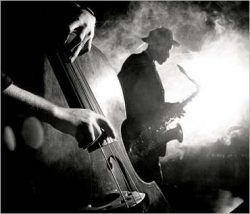Artist-Educators, Blog, Cuba, Jazz on the Tube Interview, Podcasts, The Cuba-US connection, Travel to Cuba

Interview
Download the mp3 here
For further study:
M-Base.com
More information about Steve Coleman is available at M-Base.com including a detailed biography, upcoming gigs and projects, music (which you can download for free), scores, essays and interviews.
Steve’s essay on Charlie Parker is must reading.
M-Base.net
You can register here for free at m-base.net and watch the trailer for the film “Elements of One” that Steve and I talked about.
The complete film is also available for online streaming from the site for $18.00 and is well worth it.
Mongo Mangue, the piece Steve and I discussed in the interview that features Charlie Parker playing with Machito and his Afro-Cubans
– Ken McCarthy
Jazz on the Tube
P.S. Our unique programming is made possible by help from people like you. Learn how you can contribute to our efforts here: Support Jazz on the Tube
Thanks.
Latin Jazz, Puerto Rico, Video
New York City has a large Puerto Rican population.
At the time of this recording, the community was under attack in ways that are scarcely imaginable today.
In the Bronx, scores of blocks of housing and businesses had been taken by eminent domain and destroyed to make room for highways; essential city services like police and fire department were withdrawn; banks refused to make loans to build, purchase and improve property; landlords set fire to apartments to collect insurance money.
Employment and educational opportunities were scarce, young men were returning home from Vietnam with drug problems, the crime rate was sky high.
Did music play a role in helping this community survive and even thrive in the face of crushing challenges?
I think it’s pretty obvious from this video it did.
For more information on this time:
The Bomba and Plena of the South Bronx
Bobby Sanabria, Latin Jazz and Our Beloved Bronx
More from this amazing day in the park in 1972.
Yes that is Eddie and Charlie Palmieri together.
By the way, look at that audience. Thousands of enthusiastic young people grooving to Latin Jazz.
When’s the last time you went you went to a concert with energy like this?
– Ken McCarthy
Jazz on the Tube
Afro-Cuban culture, Artist-Educators, Blog, Jazz on the Tube Interview, Latin Jazz, Podcasts, Puerto Rico, The Cuba-US connection, Video and audio

Interview
Download the mp3 here
I say our beloved Bronx because the Bronx is a cultural treasure that all Americans can be proud of.
In this wide-ranging and fascinating conversation, Bobby Sanabria talks about the state of jazz education, the historic and ongoing contribution to jazz by Latin music and musicians, and the history of the Bronx, one of the most important centers of musical innovation in the modern world.
“The soul of the people of the Bronx is one of resilience, resistance, and pride,” Mr. Sanabria said. “It really is a majestic history.” (New York Times)
Additional references:
The official Bobby Sanabria Web Site
BMHC just broke ground last month, on January 13th, on what will be a 300-seat theater as part of a massive housing complex of over 300 apartments on E. 162nd St. and Elton Ave in the Melrose section of the South Bronx. It will open in December of 2018. This will be the permanent home of the Bronx Music Heritage Center.
From Mambo to Hip Hop
Before the Fires: An Oral History of African American Life in the Bronx from the 1930s to the 1960s by Mark Naison and Bob Gumbs Info about the book “Before the Fires”
The Clave – The Key: Africa, the Caribbean and New Orleans
What New York City sounded like when Bobby was 15. The Puerto Rican community gathers at at the Bandshell in Central Park.
– Ken McCarthy
Jazz on the Tube
Afro-Cuban culture, Blog, Cuban Jazz, Latin Jazz, The Cuba-US connection

Giovanni Russonello shines a light on two things we’ve been writing about a lot in recent years:
The sublime pleasures of Latin Jazz and the incredible new generation of players and composers who merit a lot more attention than they are currently getting.
This appeared in today’s (February 11, 2017) New York Times:
Latin Jazz is Booming. Look Beyond the Grammys to Find It.
By Giovanni Russonello
When the Grammy Awards eliminated the category of best Latin jazz album six years ago, an outcry arose quickly. Musicians and advocates argued that the move cut off a rare source of institutional recognition for a genre at the commercial fringes. And the academy listened. The next year the category returned.
In the years since, the importance of that recognition has become even clearer: Latin jazz is experiencing a kind of creative bloom, with musicians diversifying their work at an uncommon clip. It’s generating some of the most invigorating improvised music around.
So maybe it is a bit disappointing that the Grammy nominations this year don’t fully reflect those developments, focusing instead on older musicians. Every nominee up for best Latin jazz album this Sunday is over 60.
More: https://www.nytimes.com/2017/02/10/arts/music/grammys-latin-jazz.html?_r=0
– Ken McCarthy
Jazz on the Tube
P.S. Our unique programming is made possible by help from people like you. Learn how you can contribute to our efforts here: Support Jazz on the Tube
Thanks.

Blog, Cuba, Cuban Jazz, Latin Jazz, The Cuba-US connection, Video and audio
New Orleans and Havana have a long history together.
For a while (1762 to 1802) when Louisiana (“Luisiana” in Spanish) was a Spanish holding, New Orleans was administered by Havana and the Spanish left behind many beautiful buildings.
Much of the French Quarter was actually built by the Cubans after a catastrophic fire destroyed most of the old city in 1788.
U.S. troops about to enter the Spanish-American War, which included the liberation of Cuba from Spanish control, shipped out of New Orleans and returned there (which is why New Orleans was full of used brass instruments around the turn of the century.)
Also, several members of important community brass bands were part of the force that invaded and then occupied Havana after the war. You can be sure they brought back some Cuban feel from the experience.
Dave Bartholomew, the New Orleanian who put his formative stamp on rock ‘n roll in the late 1940s, says he got the riff from his iconic “Country Boy” (used later on thousands of rock tunes including Elvis Presley’s “Hound Dog”) from a Cuba Son record.
And on and on it goes.
The history continued in January of 2017 with a visit by high school jazz students from Havana to New Orleans, the first such visit in at least 60 years (possibly the first such visit ever.)
The kids worked with musicians at Preservation Hall and gave a performance which was received enthusiastically by the city’s discriminating jazz fans.
In the captions below, we note the names of the Cuban educators who train and manage the band, two of the great unsung heroes in the Horns to Havana organization: Enrique Toledo and Camilo Moreira.
 Orchestra Director Enrique Toledo
Orchestra Director Enrique Toledo
 Camilo Moreira conducts
Camilo Moreira conducts
 Standing ovation in New Orleans for the kids from Cuba
Standing ovation in New Orleans for the kids from CubaEnrique Toledo conducts the Conservatorio Amadeo Roldán Jazz Orchestra in Havana, January 2016.
– Ken McCarthy
Jazz on the Tube
P.S. Our unique programming is made possible by help from people like you. Learn how you can contribute to our efforts here: Support Jazz on the Tube
Thanks.
Afro-Cuban culture, Blog, Cuba, Cuban Jazz, The Cuba-US connection, Video and audio
Steve Coleman in Matanzas (2017) with members of Rumba Timba. The group is made up of some of the younger members of Los Muñequitos de Matanzas. Luis Cancino Morales on the bells.
2016 marked Steve Coleman’s 20th year of exploring and playing in Cuba.
It all started with Coleman’s interest in the philosophical underpinnings of music and how complex cultural ideas are transmitted through music.
Anyone interested in this subject has to look to Africa and anyone in North America interested in African culture would do well to take a prolonged trip to Cuba.
Why Cuba?
For one thing it’s closer, but more importantly for historical reasons the concentration and variety of African cultural systems in Cuba is unprecedented anywhere on earth – even in Africa itself.
Coleman’s first visit to Cuba was in January 1996 where he wisely went straight to Mantazas one of the wellsprings of Afro-Cuban Culture.
This was followed up by a twelve day long collaboration in Havana with AfroCuba de Matanzas in February of the same year.
This initial collaboration culminated in a performance at the Havana Jazz Festival and a recording session at Egrem which produced the album “The Sign and The Seal by Steve Coleman and The Mystic Rhythm Society.
Here’s a documentary shot during the years right before Coleman went to Cuba (1993 to 1995).
In addition to being a composer, band leader, and instrumentalist, Coleman is also an educator.
– Ken McCarthy
Jazz on the Tube
P.S. Our unique programming is made possible by help from people like you. Learn how you can contribute to our efforts here: Support Jazz on the Tube
Thanks.


